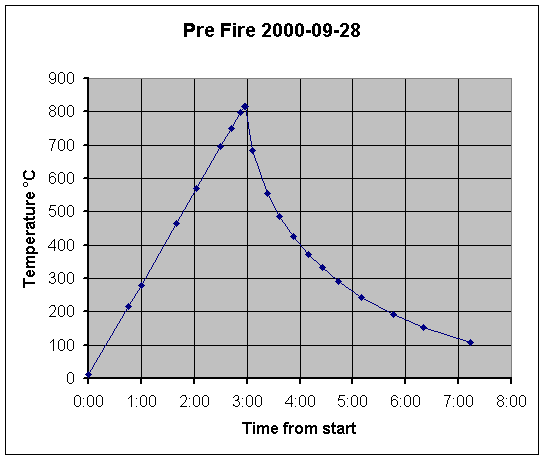
| Technical information |
| I acquired an Evenheat GTS 23-9 glass kiln during 2000, and took it through its paces. These are some of my results as I observed the kiln and tested it. My kiln is wired for 240V 30A (7200W) single phase 50Hz, and accommodates a 540mm (21") circular shelf. It has a Rampmaster II digital controller and a Type K thermocouple. Evenheat rate the controller as being accurate to ±10°F (for most of us ±5.5°C). The display reads to individual degrees, but I can't remember seeing any statement about the accuracy of the thermocouple system. The kiln was new, straight from the factory. |
| Pre Firing |
| Evenheat recommend a Pre Fire before doing any serious work to drive off moisture and to condition the elements. This should be programmed to raise the kiln temperature to 815°C (1500°F) over three hours at 270°C/hr (500°F/hr). OK, being one of those rare people that read manuals, I did this with the kiln completely empty. |
| Here is the time-temperature graph showing that the kiln did a good job of meeting the three-hour programmed top temperature. Each point represents a time when I checked the kiln and read the displayed temperature. It also shows the rate at which the kiln cooled after the program was complete, which gives me some data on the fastest I can expect the kiln to ever cool (without opening the lid). Normally the shelf, glass and any other stuff inside add extra mass which will slow down the natural cooling rate of temperature change. (Same heat loss rate + more hot stuff = slower change in temperature.) |
 |
| I analysed the rates of temperature change too, and they confirm that the heating elements were able to maintain the programmed rate constant over the whole up cycle, perhaps falling off very slightly at high temperatures with the time to reach top temperature only a couple of minutes behind that programmed. The cooling rates are naturally fastest at high temperatures, and show a maximum of perhaps 900°C/hr at ~800°C. |
| Mathematical analysis of heat loss |
| The temperature in the lower cooling range roughly fits an exponential e-t/T with a time constant T of about 2 hr. If you don't know the maths, amongst other things this means that for any period T the temperature difference above room temperature at the end is 37% (1/e) of its value at the start. So if you are starting at say 414°C and the room is at 20°C, after T hr you are at 165°C = 20+(414-20)/2.718, then after 2T at 73°C = 20+(165-20)/2.718 and getting close to being ok to open the kiln. It works for °F without any change. |
| Alternatively if you know the switch-off temperature C1, you want to open the kiln at temperature C2, and the room temperature is Cr, the time to reach opening point = T x ln((C1-Cr)/(C2-Cr)) where ln is the 'natural logarithm' function. |
| Scientifically, the lower temperature range is expected to follow this pattern as the kiln rate of heat loss is mainly determined by conduction through the fire-brick, then carried away by convection in the air. Near the top working temperatures the kiln may not be in a temperature steady-state because so little time is spent there in glass working; the rate of temperature drop is likely to be higher than predicted by this simple formula. |
| Tests on a loaded kiln |
| About a week and four firings later, I conducted another test during a slump firing of Spectrum glass. This time the kiln was loaded with its posts and shelf, and a normal amount of glass, so the performance of the kiln should be typical of any firing without a heavy mold. This data is much more accurate. Here is the firing data (black:as planned, purple:actual, and blue:predicted cooling). Nowadays I crash cool to 550°C, but here I was being a bit cautious. |
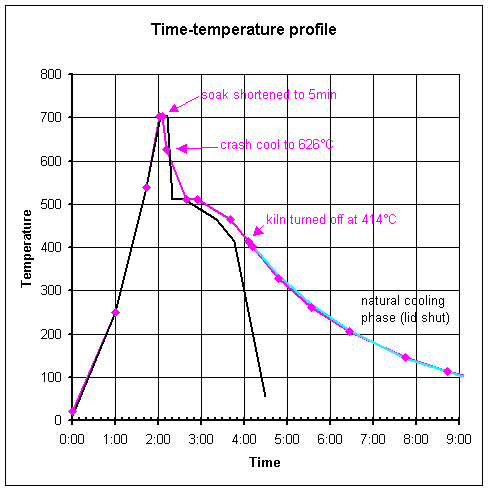 |
| Again the elements kept the heating almost up to the planned schedule, reaching top temperature only 2 minutes late. I opened the lid to crash cool down to 626°C, and then left the kiln alone except for cancelling the last segment since it was rather pointless. The final part of segment 4 down to the annealing soak put the rest of the schedule 20 min late. |
| The cooling rate after leaving the annealing phase corresponds to a time constant of 3.16 hr (3h 10m) to within a degree, so this is a good figure to use for prediction. The downloadable spreadsheet contains a programmed cell that you can use to predict natural kiln cooling performance for any temperature range. If I am not in a hurry, I just leave the kiln to cool this way sometimes overnight. Want to know more about the theory? |
| My practice |
| Since the natural cooling rate is much slower than necessary for anything I've made to date, I've adopted the practice of programming the controller only to the end of annealing, after three up segments (soak at top) and three down segments (soak before annealling ramps), and letting the kiln cool naturally thereafter. When it reaches under 300°C (not critical), I lift the lid up by 35mm (1 3/8") and connect the handle to a hook on a chain from the ceiling, to encourage it to cool faster (20mm = 2 chain links). When it reaches 200°C I open it another two links. Not much faster; about 3h to 50°C instead of 6h, so about 100°C/h average. So far nothing has cracked in cooling. But I can start many firings when I get up at 07:30 (7:30 am), be at process top by 09:30-11:00 and have the results out by 19:00 (7 pm). For thick glass, don't do this!!! |
| Download |
| These are Excel™ workbooks with all the actual data. You can edit them for similar tests on your own kiln, if you know something about Excel or know someone who does. |
| Prefiring record (62 kB) |
| The workbook contains the schedule as programmed, the observed times and temperatures, analyses, a time-temperature graph, and a time-rate graph. |
| Slump record (62 kB) |
| The workbook contains the schedule as programmed, the observed times and temperatures, predicted cooling, a time-temperature graph, and a cooling time calculator. |
| Even firing |
| I carried out the tests for even firing that Bullseye recommend in their Technotes 1, but modified for Spectrum. The results were very satisfying. Here is the 'before state' of the high temperature uniformity fuse test (kiln as loaded; the five test pieces are in a '5' die pattern), and the fused samples in the same order ('after state'). I used a single base layer with maximum thickness of four layers (Bullseye suggest a double thickness base); I used the small colour squares to code the test pieces for position. |
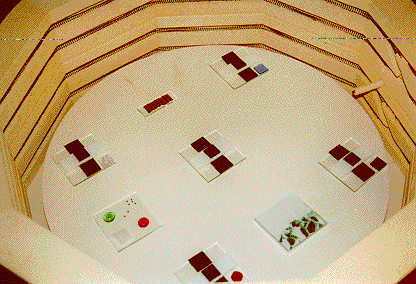 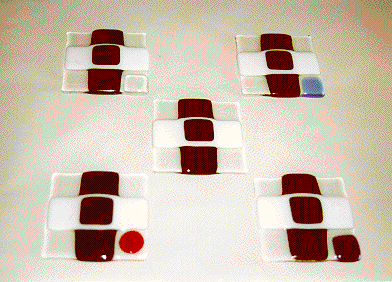 |
| Here is the 'before state' of the low-temperature uniformity test (using the onset of slumping). The supports are small flowerpots; pieces of fire-brick are alternatives of you have them. The glass is float, why waste better glass? |
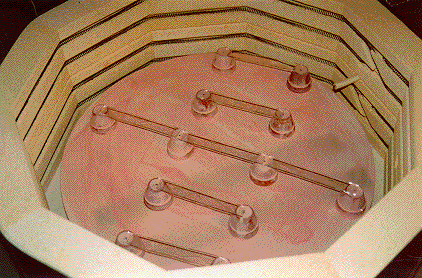 |
| Kiln Hook |
| Here is a cheap kiln hook I made to lift the kiln lid when crash cooling or speeding up the final cooling to room temperature. A piece of steel, bent, threaded at one end, and a crosspiece of wood with nuts either side. Or use pre-threaded rods. About 300mm long. |
 |
| Disclaimer |
| Use of this data is strictly at your own risk. I disclaim all responsibility for any injury to yourself, loss of funds, or damage to your property or any glass product you may make. |
| © Copyright 2000, 2001 AHJ Sale |
| Page last modified on 2001 October 24 |